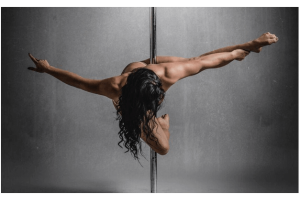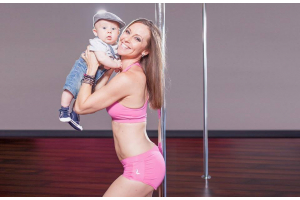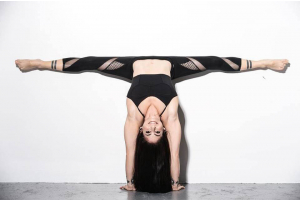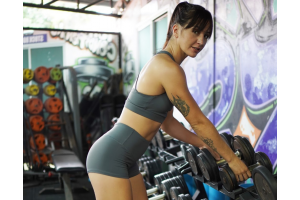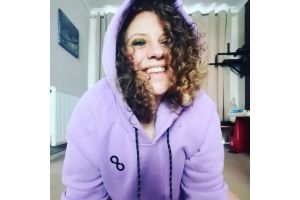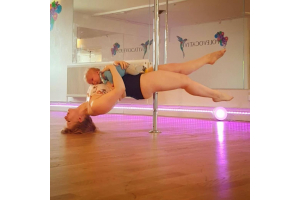10 Pro Pole Dancers give their Top 3 Training Tips
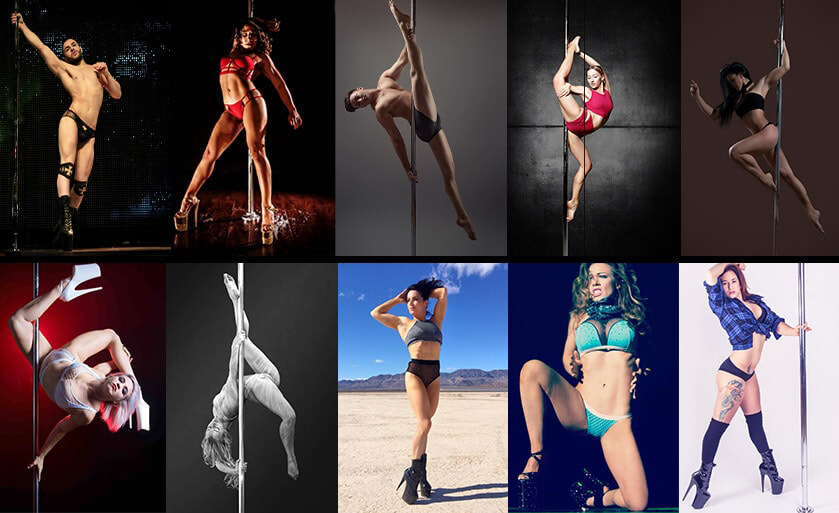
As 2017 draws to a close I've talked to a few fellow pole dancers to get their insights about training, so we can improve both on and off the pole. Here is what they shared:
Table of Contents:
Bendy Kate:
1. PREHAB! Condition your body before it's too late. Prevent injuries by doing prehab instead of rehab. Pole is such an extreme sport, so your body needs to have a certain level of all-round fitness (at that doesn't just mean cardio!) to be able to cope with the extreme positions and forces put through the body. It's a little naive of us to think we can go from doing no or little sport/activity to then become an amazing pole dancer. The same goes for sitting down all day then jumping straight into a pole session. We need to prepare the body for the epic sh*t we're about to do!
2. Explore different music! This might be the key to having a great training session or making up the best routine to date.
3. Don't be afraid to think outside the box. Don't do something just because everyone else is doing it. Be unique and be yourself. Especially on stage - a little bit of weird can be magical!
Mario Turco:
1.Train listening some song that really pushes you. Don't turn up the volume too much, listen to your breath!
2.Planning an appropriate timetable for your goals.
3.Reward yourself with something you love at the end of your daily training (I'm a bit too much a sweet tooth)
Dan Rosen:
1. Look after your body. Ensure you are resting enough and having time off from pole. Your body will thank you for it. Try and have regular massages or Epsom salt baths. Look after your body and it will look after you.
2. Don't be afraid to make a fool of yourself (I have made a career out of being a fool haha). If you fall out of a move and it didn't go as planned, laugh at yourself. Don't take it all too seriously. Pole is a fun sport and we should keep the fun alive by not taking everything so seriously when we train.
3.Warm up and Cool down. It sounds stupid but so many people don't warm up their bodies enough before exercising. I do a warm-up and then I start with basic spins on both sides and make them progressively harder to warm myself up. I don't train properly until my body has started to feel warm and ready to move the way I want it to. And cool down is just as important. After such a hard workout it needs to be stretched out. Use this opportunity to utilise your warm body and stretch it out. Maybe finish with some split training or some back bending.
Tiff Finney
3 things allow for limitless pole progress. Posture, Performance and Perception
1. Posture
Posture is instrumental to technique and strength. Standing with the posture of a ballet dancer both in entry and during your pole and floor work will engage your muscles. Until our muscles are engaged, we will only be able to train to a tiny percentage of our true capability. You are already capable of achieving some of your nemesis tricks RIGHT NOW without you even realising it. Look up posture tips and let it take your training to a new level
2. Performance
Try to practice pole work as though there is an audience. Filming yourself helps. Don't just put your hands on the pole to do a spin. Extend the arm out before putting it on the pole like you want an oscar, look up and out with intent during the spin, land it like you just did Torville & Dean's Bolero. You will undoubtedly enjoy pole so much more and you owe it to yourself to give the trick/spin the credit it deserves. It also helps you to really link in posture and therefore helps with your technique and strength too!
3. Perception
"Oh, I can't do that because my injury/my genetics/shoulders are too stiff/ weren't born with that skeletal makeup" yadda yadda yadda. Stop focussing on what you can't change. It's a tremendous waste of your time to what you could be doing. And doing really well! My spine is fused and doesn't bend. Who cares. I have a tight core instead. I have a shit straddle fold but I have great adductors. I have stiff shoulders but I have hypermobility in my ankles (floppy ankles ahoy). We are ALL genetically gifted. Why the fuck are we wasting time moaning about what doesn't help our training when we could be killing it with the phenomenons that we were gifted with? Embrace your genetics or reject them. Embrace them and all you can do is progress. Reject them and you'll only regress.
Carmine Black
1. Cross-training and exploring restorative movement to support active pole training: Though there are many benefits to doing Pole, exploring the modality long term can some adverse effects on the body. Overtraining one side, while neglecting our less dominant side; doing the same movements in repetitively, or doing movements/tricks/transitions without proper conditioning or training makes us prone to injury. I weight train 3-4 times a week and do yoga on a regular basis to support all of the dancing that I do.
2. Stretch, Roll, Release! : I stretch at least 4 times a week. I treat my stretch routines like my workout routines. I will pick a day to open my chest and front body, next day I focus on my traps and upper back, the following day I work on middle back/side body/core, last day I focus on hips/glutes/legs. Every day I do rotational movement to open up my joints, as well as roll out every other day. It really helps to keep me mobile. When I have the time, I treat myself to massages, acupuncture treatments and saunas.
3. The most important tip of all: Rest days!!! If you are an avid trainer, you need at least 1 day of rest and an adequate amount of sleep to maintain stamina when training.
Jazzy K
1. Listen to your Body When we are training we try to overcome our limits, get better and stronger. No pain no gain is what we read everywhere. Go hard or go home. Yes, we want to push ourselves to grow but listening to our body and its needs is a skill that you have to learn as well. When is it just the inner laziness that we all have sometimes, that tells us to stop and when does the body really need a break? Where does our ego to really nail that move scream louder than the voice that protects us and wants us to try next time again? If you know your body's weaknesses and strengths you can grow better and stay healthy while becoming the pole dancer you always wanted to be.
2. Aaaand ACTION! - Film Yourself When dancing, a lot is about how it feels and not right away about how it looks, but in the end, we all would like to dance as graceful or sexy as our idols. The best way to see if the own body awareness is correct, filming in between can help a lot to improve the own movement and details. Are you really straightening that leg that you are so convinced off but your teacher is telling you to straight more all the time? But especially when you train alone, filming can help to give yourself feedback or compare with your goal movement and finding mistakes. As I have not had a regular instructor for years, this is what helped me the most to get better and develop my own style, as I often film during freestyles as well. This way I discover new things or tiny details that I like or dislike that no one else could tell me as it is my very own taste.
3. Freestyle, freestyle, freestyle I love flowing into and out of my movements, feeling the music and working on beats and lyrics. If you feel stuck sometimes in your creativity and feel like nothing really flows at all, the best thing to practice is freestyle. To dance freely (especially if you don’t come from a dance background) is often very hard and feels awkward in the beginning. But trying to follow your body without too much intention of your mind can bring you in so many new transitions and help you also with writing a routine. While having certain combos that you love to do is great, trying to go the other way that you normally would open a whole new world. Put on music that you love, don’t be afraid to look weird (I „fail“ in Freestyles all the time) and just try to focus on where it pulls you. Be confident, enjoy and just move!
Anastasia Skukhtorova
1. I think one of the most important things is warm up. I always wear a lot of clothes when I start my training. Warm up belt, socks, leg warmers, pants. Anything that can keep my body warm and healthy.
2. Drink plenty of water during the day. Water is life. Then it is very important to listen to your body. There are some days when you feel more pain or you just don’t feel flexible or strong, so I don’t push it. I try to find other ways to train. Maybe exploring more low flow around the pole, or only floor/ more dancing. I believe also that everyone should find their own way of stretching or training. As we all so different. What works for one doesn’t work for another.
3. If you can try to take as many classes, workshops, lessons with different people so you can find what suits you the best. For me the best results I had when I was stretching and training at least 4 times a week. I did some private ballet classes and then flexibility afterwards. Ballet warms you up so much. That it is so much easier to stretch. You will get beautiful lines, pointed toes and strength. Good luck with your training - Love Anastasia.
Jordan Kensley
1. DRINK WATER. An athlete should be drinking at least 3L of water a day, more if it’s a training day.
2. USE PREVENTATIVE CARE NOW! Acupuncture, massage, chiropractic, physio, Structural Integration, rest days (actually resting), proper stretching and conditioning before and after training.
3. USE POSITIVE REINFORCEMENT FOR YOURSELF. Even on shit days, find something you worked on that you’re proud of. It makes such a difference and gives you & your body subconscious reinforcement to continue down that path of good energy and Good training days.
Jamilla Deville
1. The higher/ harder you train, the more pre-hab and recovery you need. Pre-hab exercises create strength and balance to help prevent injury. Recovery can be anything from your nutrition to your mode of relaxation to sleep. They are every bit as important as what you do on the pole!
2. Be aware of what movements you're training in each session and what part of the body is most stressed in each. Structure your training so that your body has the chance to recover from the workout of the day or two before. For example, if you trained repetitions of deadlifts one day, give your shoulders a break the next (in particular from repetitions of the same movement).
3. Explore different styles! Try heels, and also train without. Train with different teachers; each will often favour certain movements or patterns of movement. This will not only allow your body to adapt to a greater range of movement but will train your mind in multiple styles as well.
Me! (Sarah Scott)
1.Posture then Mobility then Flexibility. Take note of how you sit, stand and move in everyday life and we do that for many more hours a day than we train! It can have much more of an impact than you’d think. If you’re starting off in a bad position which your shoulders rounded forward from being sat at a desk all day then jumping straight to stretching your shoulders – they won’t perform optimally. Take the time to move and mobilise every day, even if it’s for 10min – little and often soon add up.
2. Celebrate the little successes – set yourself small challenges to keep motivated and positive during training.
3. Enjoy the journey. If it was that easy – it wouldn’t be as rewarding! You have to go through a lot of repetition to master a movement, and your body needs time to adapt. Taking a step back and seeing how far you’ve come can be a reminder that pole dancers are basically ninja unicorns and what you can already do is already badass. The trick will come, the splits will improve, you just have to be consistent, realistic and look after your body as you only get one!
And that's that! Hope you can find a couple of pointers that will help you take your pole dance to next level, next year. And remember, train smart - dance more!
XO

